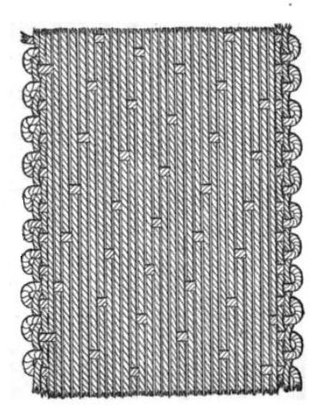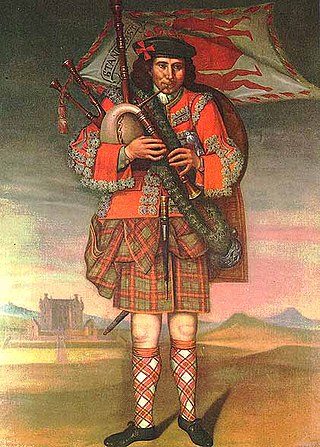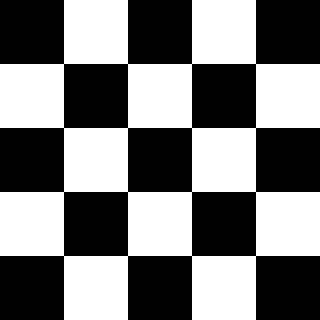
A kilt is a garment resembling a wrap-around knee-length skirt, made of twill-woven worsted wool with heavy pleats at the sides and back and traditionally a tartan pattern. Originating in the Scottish Highland dress for men, it is first recorded in the 16th century as the great kilt, a full-length garment whose upper half could be worn as a cloak. The small kilt or modern kilt emerged in the 18th century, and is essentially the bottom half of the great kilt. Since the 19th century, it has become associated with the wider culture of Scotland, and more broadly with Gaelic or Celtic heritage.

Madras is a lightweight cotton fabric with typically patterned texture and tartan design, used primarily for summer clothing such as pants, shorts, lungi, dresses, and jackets. The fabric takes its name from the former name of the city of Chennai in south India.

A satin weave is a type of fabric weave that produces a characteristically glossy, smooth or lustrous material, typically with a glossy top surface and a dull back; it is not durable, as it tends to snag. It is one of three fundamental types of textile weaves alongside plain weave and twill weave.

Tartan is a patterned cloth with crossing horizontal and vertical bands in multiple colours, forming simple or complex rectangular patterns. Tartans originated in woven wool, but are now made in other materials. Tartan is particularly associated with Scotland, and Scottish kilts almost always have tartan patterns.

A blouse is a loose-fitting upper garment that may be worn by workmen, peasants, artists, women, and children. It is typically gathered at the waist or hips so that it hangs loosely ("blouses") over the wearer's body. Today, the word most commonly refers to a girl's or woman's dress shirt, although there is considerable confusion between a true blouse and a women's shirt. It can also refer to a man's shirt if it is a loose-fitting style, though it rarely is. Traditionally, the term has been used to refer to a shirt which blouses out or has an unmistakably feminine appearance, although even many "standard" shirts today have a somewhat blousy fit, and the numbers of men wearing such shirts may match that of women wearing actual blouses.

Gabardine is a durable twill worsted wool, a tightly woven fabric originally waterproof and used to make suits, overcoats, trousers, uniforms, windbreakers, outerwear and other garments. Often associated with the Burberry fashion house and their synonymous trench coats, the original reference, "gaberdine", it related to the long, cape-like dress worn during the medieval era.

Flannel is a soft woven fabric, of varying fineness. Flannel was originally made from carded wool or worsted yarn, but is now often made from either wool, cotton, or synthetic fiber. Flannel is commonly used to make tartan clothing, blankets, bed sheets, sleepwear, and several other uses.

Highland dress is the traditional, regional dress of the Highlands and Isles of Scotland. It is often characterised by tartan. Specific designs of shirt, jacket, bodice and headwear may also be worn along with clan badges and other devices indicating family and heritage.

A dress shirt, button shirt, button-front, button-front shirt, or button-up shirt is a garment with a collar and a full-length opening at the front, which is fastened using buttons or shirt studs. A button-down or button-down shirt is a dress shirt with a button-down collar – a collar having the ends fastened to the shirt with buttons.

The belted plaid is a large blanket-like piece of fabric which is wrapped around the body with the material pleated or, more accurately, loosely gathered and secured at the waist by means of a belt. Typically, a portion of the belted plaid hangs down to about the knees or ankles with the rest of the material being wrapped up around the upper body in a variety of ways and pinned or otherwise secured to keep it in place.

Houndstooth, hounds tooth check or hound's tooth, also known as dogstooth, dogtooth, dog's tooth,, is a duotone textile pattern characterized by a tessellation of light and dark solid checks alternating with light-and-dark diagonally-striped checks—similar in pattern to gingham plaid but with diagonally-striped squares in place of gingham's blended-tone squares—traditionally in black and white, although other contrasting colour combinations may be used.

Fashion in the years following World War II is characterized by the resurgence of haute couture after the austerity of the war years. Square shoulders and short skirts were replaced by the soft femininity of Christian Dior's "New Look" silhouette, with its sweeping longer skirts, fitted waist, and rounded shoulders, which in turn gave way to an unfitted, structural look in the later 1950s.

Workwear is clothing worn for work, especially work that involves manual labour. Often those employed within trade industries elect to be outfitted in workwear because it is built to provide durability and safety.

Border tartan, sometimes known as Borders tartan, Northumbrian tartan, Northumberland tartan, shepherds' plaid, shepherds' check, Border drab, or Border check, is a design used in woven fabrics historically associated with the Anglo-Scottish Border, particularly with the Scottish Borders and Northumberland. Possibly the most identifiable Border tartan garment of the region is the maud, made popular from the 1820s by fashionable Border Scots such as Sir Walter Scott, James Hogg, Henry Scott Riddell and Robert Burns.

Check is a pattern of modified stripes consisting of crossed horizontal and vertical lines which form squares. The pattern typically contains two colours where a single checker is surrounded on all four sides by a checker of a different colour.

Tattersall is a style of tartan pattern woven into cloth. The pattern is composed of regularly-spaced thin, even vertical warp stripes, repeated horizontally in the weft, thereby forming squares.

Fashion and clothing in the Philippines refers to the way the people of the Philippine society generally dress up at home, at work, travelling and during special occasions.

A stripe is a line or band that differs in color or tone from an adjacent area. Stripes are a group of such lines in a repeating pattern of similar regions.

A maud is a woollen blanket or plaid woven in a pattern of small black and white checks known as Border tartan, Shepherd's check, Shepherd's plaid or Galashiels grey. It was in common use as an item of clothing in the southern counties of Scotland and the northern counties of England until the early twentieth century.
Tissue is a thin, transparent, and lightweight material. Tissue fabric is a suitable material for designing various types of garments, including saris. Tissue is characterized by the use of metallic yarns for decorative purposes. The tissue sari is composed of silk threads in the warp and zari in the weft.




















